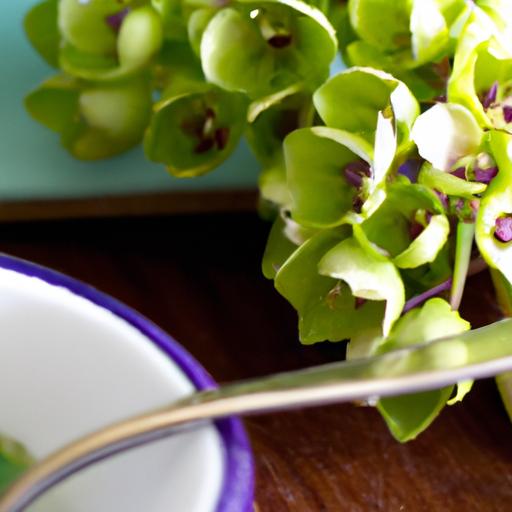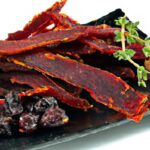There’s a subtle magic in capturing the fleeting essences of spring and summer, bottling them into flavors that surprise and delight the palate long after the blooms have faded. Chive blossoms, with their delicate purple hues and gentle onion aroma, offer a unique opportunity to elevate your culinary creations. Crafting chive blossom vinegar is more than just a preservation method-it’s an artful way to infuse your kitchen with the fresh, vibrant spirit of the garden. In this step-by-step guide, we’ll explore how to transform these charming flowers into a tangy, fragrant vinegar that adds a burst of herbal brightness to dressings, marinades, and more. Whether you’re a seasoned forager or a curious cook, get ready to harness the floral notes of chive blossoms and create a pantry staple that captures nature’s bounty in every drop.
Gathering and Preparing Fresh Chive Blossoms for Optimal Flavor
Crafting Chive Blossom Vinegar begins with handpicking delicate, fragrant chive blossoms at their peak. For the most vibrant flavor, choose fully opened, bright purple flowers on dry, sunny days-morning hours are ideal before the sun’s heat dulls their essence. Gently pluck the blossoms without bruising to preserve their subtle onion-like aroma and floral notes.
Once gathered, cleanse the blossoms by briefly rinsing them under cold water or placing them in a bowl of ice water to remove any dirt or tiny insects. Pat dry thoroughly using a clean kitchen towel or paper towel-excess moisture can dilute the vinegar’s infusion and affect fermentation.
Infusing Techniques to Capture the Essence of Chive Blossoms
Infusing to unlock the full bounty of chive blossom flavor requires patience and precision. Place the dried blossoms in a sterilized glass jar and cover them completely with a high-quality, mild white wine vinegar or apple cider vinegar. Seal the jar tightly and store it away from direct sunlight in a cool, dark place.
For an intense, balanced infusion, let the blossoms steep for at least two weeks, shaking the jar gently every couple of days to mix the flavors. This slow extraction process ensures the vinegar absorbs the delicate, herbaceous qualities of the blossoms while maintaining clarity and brightness. Avoid using distilled vinegar, as it lacks the complexity needed to complement the chive blossoms.
Balancing Ingredients and Fermentation Tips for Perfect Vinegar
When crafting chive blossom vinegar, it’s essential to balance acidity with floral sweetness. Use a vinegar with 5-6% acidity, which is ideal for preserving freshness and safety during fermentation. To add depth, consider infusing a sprig of fresh thyme or a small clove of garlic alongside the blossoms-but keep additions subtle to avoid overpowering.
Fermentation is an art here-if you prefer a more pronounced vinegar tang, extend fermentation by a few weeks, tasting periodically. Filter the blossoms through a fine mesh sieve after infusion, then bottle your vinegar in sterilized containers. Store refrigerated or in a cool pantry to prolong shelf life and flavor integrity.
Creative Uses and Storage Solutions to Enhance Your Chive Blossom Vinegar
Chive blossom vinegar is a culinary treasure trove. Drizzle it over spring salads, roasted vegetables, or fresh seafood to add a light, oniony zing. It makes a perfect base for vinaigrettes or brightens marinades and pickles. Garnish with fresh chive sprigs for a stunning presentation.
For storage, use dark glass bottles to shield the vinegar from light, and add a tightly fitting cork or cap to maintain its aromatic profile. Keep refrigerated after opening for up to six months. Gift this artisanal vinegar beautifully adorned with a hand-tied ribbon and label, making it a charming present for food lovers.
Prep and Cook Time
- Prep Time: 15 minutes
- Infusion Time: 14-21 days
Yield
- Approximately 1 cup (240 ml) of chive blossom vinegar
Difficulty Level
- Easy to Medium
Ingredients
- 1 cup fresh chive blossoms, cleaned and dried
- 1 cup mild white wine vinegar or apple cider vinegar (5-6% acidity)
- Optional: 1 small garlic clove, peeled
- Optional: 1 sprig fresh thyme
Instructions
- Prepare the blossoms: Gently rinse fresh chive blossoms under cold water, then dry completely on a clean towel to avoid excess water diluting the vinegar.
- Fill and infuse: Place the dried blossoms in a sterilized glass jar. Add optional garlic and thyme if desired. Pour the vinegar over until blossoms are fully submerged.
- Seal and store: Close the jar tightly and store it in a cool, dark place away from direct sunlight for 14 to 21 days, shaking gently every 2-3 days to redistribute flavors.
- Strain the vinegar: After infusion, strain the mixture through a fine mesh sieve or cheesecloth into a clean, sterilized bottle, discarding the blossoms and herbs.
- Store properly: Seal the bottle with a tight cap or cork. Label with the date and store in a dark cupboard or refrigerator for up to six months.
Tips for Success
- Harvest blossoms on dry days to ensure purity and avoid waterlogging your infusion.
- Use only vinegars with 5-6% acidity to guarantee preservation and food safety.
- For a clearer vinegar, strain twice through a fine sieve or cheesecloth.
- Experiment with small batches adding herbs like tarragon or edible flowers to personalize your flavor.
- Always sterilize containers to prevent unwanted bacterial growth during fermentation.
Serving Suggestions
- Drizzle over mixed greens or grain bowls for a floral, tangy finish.
- Use as a delicate acid in homemade mayonnaise or creamy dressings.
- Add a splash to steamed asparagus or spring peas for a burst of freshness.
- Pair with goat cheese and artisan breads for a sophisticated appetizer.
| Nutrient | Per 1 tbsp Serving |
|---|---|
| Calories | 3 kcal |
| Protein | 0 g |
| Carbohydrates | 0.1 g |
| Fat | 0 g |
Discover more homemade herb vinegars for your culinary creations. For detailed food safety standards on vinegar fermentation, visit USDA Food Safety and Inspection Service.

Q&A
Q&A: Crafting Chive Blossom Vinegar – A Step-by-Step Guide
Q1: What makes chive blossoms a unique ingredient for vinegar?
A1: Chive blossoms are nature’s delicate fireworks-those fluffy purple pom-poms burst with a mild onion flavor and a subtle floral sweetness. When infused into vinegar, they impart a gentle, aromatic punch that transforms ordinary salad dressings and marinades into culinary gems.
Q2: Which type of vinegar works best for crafting chive blossom vinegar?
A2: A neutral, clean-tasting vinegar like white wine vinegar or apple cider vinegar is ideal. Their brightness allows the floral notes of the chive blossoms to shine through without overpowering the infusion.
Q3: How do I select and prepare chive blossoms for the vinegar?
A3: Hunt for fresh, vibrant lavender chive blossoms on a sunny day-avoid any that look wilted or faded. Gently rinse them to remove dirt or tiny critters and pat dry. Only use the flower heads; discard the green stems to keep the flavor light and refined.
Q4: What’s the step-by-step process for crafting chive blossom vinegar?
A4: The magic unfolds in a few simple moves:
- Place clean chive blossoms in a sterilized glass jar, loosely filling it halfway.
- Pour your chosen vinegar over the blossoms, fully submerging them without overcrowding.
- Seal the jar and give it a gentle shake.
- Store it in a cool, dark place for 2-4 weeks, shaking the jar every few days to mingle flavors.
- Once infused to your liking, strain out the blossoms and transfer the fragrant vinegar into a clean bottle.
Q5: How long does chive blossom vinegar keep?
A5: Thanks to vinegar’s preservative power, your chive blossom vinegar can last up to 6 months when stored in a cool, dark cupboard. Just give it a sniff before use-if it smells off or cloudy, it’s time to make a fresh batch.
Q6: What are some creative ways to use chive blossom vinegar in the kitchen?
A6: Drizzle it over roasted veggies, whisk it into vinaigrettes, splash it into soups for brightness, or even use it to elevate pickles and sauces. Its delicate onion-floral notes add an unexpected twist that keeps your taste buds intrigued.
Q7: Can I experiment with other herb blossoms for vinegar infusions?
A7: Absolutely! Dandelion, nasturtium, or elderflower blossoms all bring distinct personalities to vinegar. Each infusion is a little alchemist’s adventure-just follow the same infusion method and enjoy your handcrafted botanical elixirs.
By following these steps, you’ll create your own jar of springtime sunshine in the form of chive blossom vinegar-ready to spritz, splash, and savor!
Future Outlook
As the final drops of your chive blossom vinegar settle into their vibrant, aromatic glory, you’ve not only created a unique condiment but also captured a fleeting moment of nature’s delicate bounty. Whether drizzled over a fresh salad, stirred into a marinade, or simply admired on your spice shelf, this homemade infusion is a testament to the beauty of patience and the magic of simple ingredients. So next time you come across those fragrant chive blossoms, remember-you hold the power to transform them into a kitchen treasure that sings with flavor and season after season, invites you to savor the craft of creation. Happy pickling!


